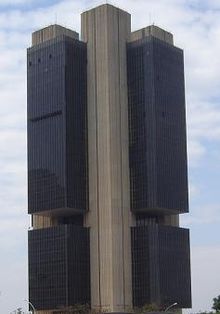
The Collor Plan (Portuguese: Plano Collor), is the name given to a collection of economic reforms and inflation-stabilization plans carried out in Brazil during the presidency of Fernando Collor de Mello, between 1990 and 1992. The plan was officially called New Brazil Plan (Portuguese: Plano Brasil Novo), but it became closely associated with Collor himself, and "Plano Collor" became its de facto name.
The Collor plan combined fiscal and trade liberalization with radical inflation stabilization measures.[1] The main inflation stabilization was coupled with an industrial and foreign trade reform program, the Industrial and Foreign Trade Policy (Portuguese: Política Industrial e de Comércio Exterior), better known as PICE, and a privatization program dubbed the "National Privatization Program" (Portuguese: Programa Nacional de Desestatização), better known as the PND.
The plan's economic theory had previously been laid out by economists Zelia Cardoso de Mello, Antônio Kandir, Álvaro Zini and Fábio Giambiagi.[1] The actual plan to be implemented was written by Antônio Kandir and economists Ibrahim Eris, Venilton Tadini, Luís Otávio da Motta Veiga, Eduardo Teixeira and João Maia.[2]
The plan was announced on March 16, 1990, one day after Collor's inauguration.[2] Its intended policies included: [3]
- Replacement of the existing currency, the Cruzado Novo by the Cruzeiro at a parity exchange rate (Cr$1.00 = NCz$1.00),
- Freezing of 80% of private assets for 18 months (receiving the prevailing rate of inflation plus 6% in interest while frozen),
- An extremely high tax on all financial transactions,
- Indexation of taxes,
- Elimination of most fiscal incentives,
- Increase in the prices charged by public utilities,
- The adoption of a floating exchange rate,
- Gradual economic opening to foreign competition,
- Temporary freeze on wages and prices,
- The extinction of several government agencies, with plans for a reduction of over 300,000 government employees,
- Stimulus of privatization and the beginning of economic deregulation.
- ^ a b Welch, John H. Birch, Melissa. Smith, Russell.ECONOMICS: BRAZIL. Library of Congress. December 30, 2004. Retrieved on September 8, 2007.
- ^ a b Carvalho, Carlos Eduardo (April 2006). "As origens e a gênese do Plano Collor". Nova Economia. 16 (1): 101–134. doi:10.1590/S0103-63512006000100003.
- ^ Villela, Anibal. The Collor Plan and the Industrial and Foreign Trade Policy Archived 2011-05-19 at the Wayback Machine. Institute of Applied Economic Research. 1997. Retrieved September 8, 2007.